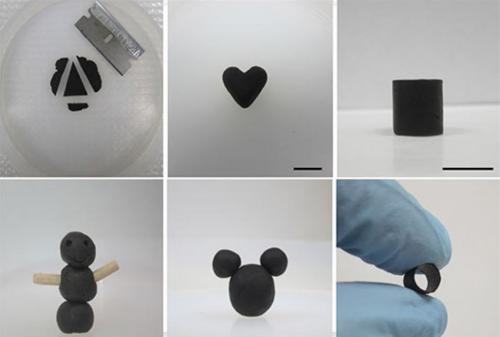
Scientists at Northwestern University are literally reshaping the world of graphene. They have turned GO (graphene oxide) into a soft, kneadable and moldable play dough. You can shape it and then reshape it into free-standing, 3D structures. They call it GO Dough.
Even though the dough is lots of fun to play with, it is not just a toy. It solves many long-standing – and even explosive – problems for companies that manufacture, deliver, store, and use graphene.
The researchers wrote about their work in the prestigious journal Nature Communications (citation below). The authors were Che-Ning Yeh, Haiyue Huang, Alane Tarianna O. Lim, Ren-Huai Jhang, Chun-Hu Chen, and Jiaxing Huang. They are all from Northwestern University.
Study leader, Jiaxing Huang, a Professor of Materials Science and Engineering, said:
“Currently graphene oxide is stored as dry solids or powders, which are prone to combustion. Or they have to be turned into dilute dispersions, which multiply the material’s mass by hundreds or thousands.”
GO Dough simplifies delivery and storage of graphene oxide
Prof. Huang recounted his most recent shipment of graphene oxide. 5 kg of graphene oxide was dispersed in 500 liters of liquid. It had to be delivered in a truck, he explained.
Five kilograms of graphene oxide in dough form, on the other hand, would weigh approximately 10 kg. Prof. Huang added: “And I could carry it myself!”
Graphene oxide is a product of graphite oxidation. Scientists often use graphene oxide to make graphene. Graphene, a single-atom-layer sheet of carbon, is the world’s strongest material. It is also the world’s lightest material.
GO Dough – just add water
The researchers made GO Dough by mixing water with an ultra-high concentration of graphene oxide.
If the scientists had used binding additives, they would have had to process the material further to remove these additives to return the graphene oxide to its pure form.
Prof. Huang explained:
“Adding binders such as plastics could turn anything into a dough state. But these additives often significantly alter the material’s properties.”
After shaping GO Dough into structures, it can be converted into dense solids which are chemically stable. They are also electrically conductive and mechanically hard.
If you want to transform it into a high-quality GO dispersion, simply add more water.
According to a Northwestern University press release:
“The dough can also be processed further to make bulk graphene oxide and graphene materials of different forms with tunable microstructures. Huang hopes that GO dough’s ease of use could help graphene meet its much-anticipated potential as a super material.”
Regarding the future of GO Dough, Prof. Huang said:
“My dream is to turn graphene-based sheets into a widely accessible, readily usable engineering material, just like plastic, glass, and steel.”
“I hope GO Dough can help inspire new uses of graphene-based materials, just like how play dough can inspire young children’s imagination and creativity.”
Citation
“Binder-free graphene oxide doughs,” Che-Ning Yeh, Haiyue Huang, Alane Tarianna O. Lim, Ren-Huai Jhang, Chun-Hu Chen, and Jiaxing Huang. Nature Communications, Volume 10, Article number: 422 (2019). DOI: https://doi.org/10.1038/s41467-019-08389-6.
